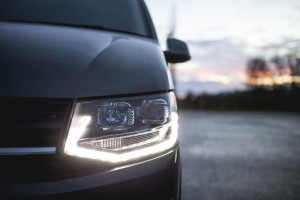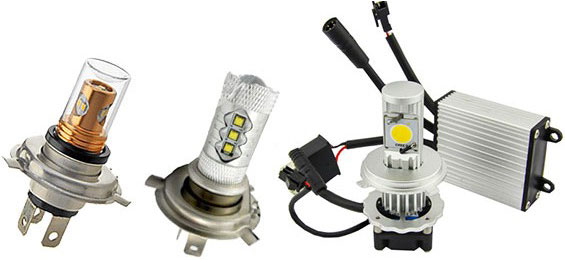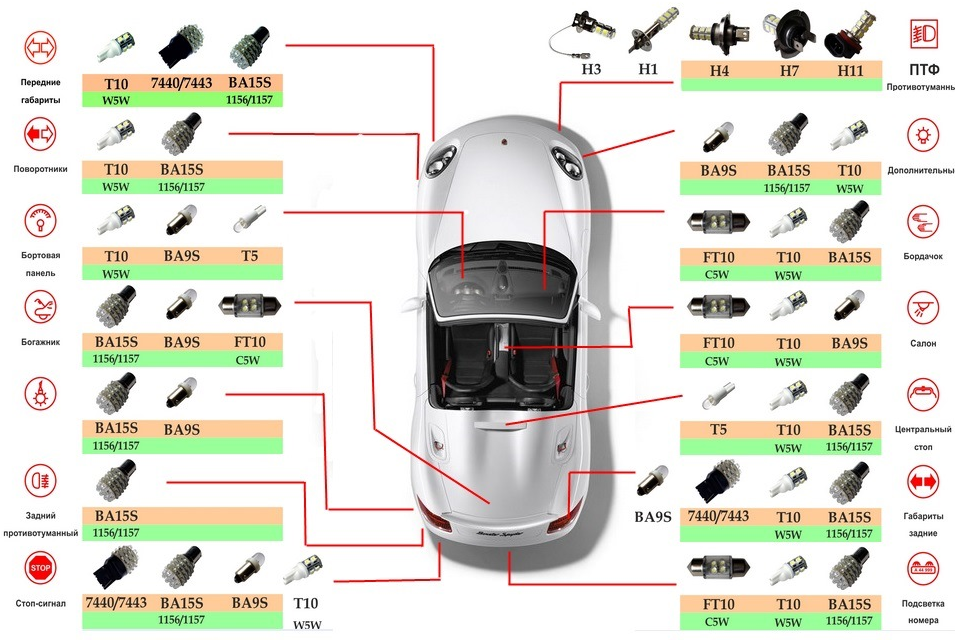
Vehicles are increasingly equipped with modern light sources - LED car lamps. Everything about these lamps, their design features, existing types, labeling and applicability, as well as the correct selection and replacement of LED lamps, is described in this material.
Purpose of LED car lamps
Automotive LED lamp (LED lamp, LED lamp) is an electric light source based on light-emitting diodes (LED) used in lamps and lighting fixtures of vehicles.
In modern vehicles, tractors and various machines there are several dozen light sources - headlights, direction indicators, brake lights, parking lights, daytime running lights, license plate illumination, fog lights, interior lighting (including glove compartment lighting), trunk lights, dashboard lights, etc. For many decades, incandescent lamps of various designs have been used, but in recent years they have been increasingly replaced by semiconductor light sources - LED lamps.
The application of LED lamps in vehicles has three key advantages:
● Reduction of power consumption - LEDs with a luminous flux power comparable to incandescent lamps consume significantly less current;
● Increase in the service interval for maintenance of lamps - LEDs have several times a longer resource than incandescent lamps, therefore they require replacement less often (and, accordingly, reduce the cost of buying new lamps);
● Improve the reliability of lighting fixtures – LED bulbs are rigid structures that do not have filaments, so they are resistant to vibrations and shocks.
Currently, LED lamps are produced that can completely replace incandescent lamps in a car. However, for the correct choice of these light sources, you should understand their design features, characteristics and plinth.
Design and Characteristics of LED Car Lamps
Structurally, LED car lamps consist of three components: a housing in which one or more LEDs are mounted, and a base for installing the lamp in a socket. The lamp is based on blue light LEDs - electrical devices based on a crystal of a semiconductor material (most often gallium nitride modified with indium), in which a p-n junction is formed, and a phosphor is applied to the emitting surface. When current is passed through the LED, its transition emits a blue color, which is converted by a layer of phosphor to white. In low-power lamps, 1-3 LEDs are used, in bright lamps - up to 25 LEDs or more.
LEDs are mounted on an insulating plate or housing made of insulating material, in rare cases they can have protection in the form of a glass bulb (like conventional incandescent lamps). Such an LED assembly is connected to a metal or plastic base, through which current is supplied to the LEDs from the vehicle's on-board electrical system.

LED car headlight bulbs
On some types of lamps, significant thermal power can be dissipated, which leads to their heating and failure. To remove heat from such lamps, additional components are introduced into the design - passive and active cooling systems. Passive cooling is provided by aluminum heatsinks located on the opposite side of the LED assembly. The heatsink usually has fins, which increases the area of the part and improves heat dissipation by convection. Radiators are equipped with relatively low-power lighting lamps - for salon shades, daytime running lights, fog lights, etc.
Active cooling systems are built on the basis of a radiator and a fan, which provides intensive blowing of the radiator to remove excess heat from it. The fan can work constantly when the lamp is on, or be controlled by automation that monitors the temperature of the device. Active cooling systems are equipped with powerful lighting lamps for headlights.
Car LED lamps are available for standard supply voltages - 6, 12 and 24 V, have a power of units of watts, for the most part they are completely interchangeable with incandescent lamps.
Marking and bases of LED lamps
It should be pointed out right away that LED car lamps are produced with the same types of caps as conventional incandescent lamps - this makes it possible to install both types of lighting fixtures in the vehicle without altering the electrical system. At the same time, in the marking of LED lamps, you can find several designations - the type of base and the type of a similar incandescent lamp. Such marking facilitates the selection of lighting fixtures, if necessary, replace the incandescent lamp with an LED one or vice versa.
In our country, there are several standards for lamps, among them is the interstate standard for bases GOST IEC 60061-1-2014 (applies to light sources of all types, including automotive, household, etc.). In accordance with this document and similar European standards (IEC and DIN), car lamps can have the following types of caps:
● BA - pin (bayonet), the pins are located symmetrically relative to each other;
● BAY - pin (bayonet), one pin is shifted in height relative to the other;
● BAZ - pin (bayonet), one pin is shifted in height and radius relative to the other;
● E - threaded (practically not used on modern cars);
● P — flanged;
● SV - soffit lamp with a double-sided base;
● W - lamps with a glass base, in relation to LED lamps - with a plastic base (often they are called lamps without a base).

Types of bases and applicability of automotive LED lamps
The numerical index of the marking indicates the diameter or width of the base, and the letter after the number indicates some design features. For example, a common BA15s base is a 15 mm diameter pin base with two symmetrically arranged pins and one lead contact, the second contact is played by the glass of the base. And the BA15d is the same base, but with two lead contacts (round or oval), the role of the third contact is also played by the glass of the base.
In parallel with the marking of the caps, marking similar to the marking of conventional automotive incandescent lamps is also used. For example, the T5 and T10 lamps are miniature cap lamps that use W5W type caps. Such a base is made in the form of a plastic plate, on both sides of which two wire contacts are displayed. Soffit lamps are often designated C5W and FT10. And the marking of LED headlight lamps is marked with halogen lamps - from H1 to H11, HB1, HB3, HB4, etc.
You also need to specify that some types of lamp caps are digitally marked. For example, BA15 plinths in some standards are marked "1156/1157", wide plinths W21 are marked "7440/7443", etc.
How to choose and replace a car LED lamp
When choosing an LED lamp (or several lamps) for a car, you should take into account the type of base and the electrical characteristics of the lighting fixture. As a rule, the instructions for the operation, repair and maintenance of the vehicle indicate the type of light sources used and their bases - these are the instructions that should be followed when buying. You also need to take into account the voltage of the vehicle's on-board network, and choose the appropriate lamps.
Special attention should be paid to the selection of lamps with bayonet (pin) bases and soffit lamps. As mentioned above, the BA, BAY and BAZ caps can be single-pin ("s" marking) and two-pin ("d" marking) designs, and they are not interchangeable. At the same time, lamps with two round and oval contacts can be installed in the same cartridge without restrictions. In order to avoid a mistake, it is necessary to pay attention to the full marking of the light source.

LED Warning Car Lamps
Soffit lamps have the same bases with a diameter of 7 mm (SV7 base, type C10W) and 8.5 mm (SV8.5 base, type C5W), and also differ in length - it can be 31, 36 and 41 mm.
Finally, when selecting LED lamps for direction indicators and parking lights, you need to take into account that they are white and amber (orange). In the marking of lamps of the second type, the letter "Y" ("yellow") is necessarily present, they have a bulb or filter with an amber color, which gives the fire the desired color using a transparent diffuser.
Replacement of LED lamps is carried out in accordance with the instructions for repair and maintenance of the vehicle. When performing this operation, it is necessary to de-energize the vehicle's on-board network. Replacement of light sources usually comes down to disassembling the lighting fixture (dismantling the ceiling or diffuser, in the case of headlights, dismantling them and / or partially disassembling them), installing the lamp in the appropriate socket, and reassembling it.
If the LED lamp is selected and installed correctly, then its light will ensure comfortable and safe operation of the vehicle for many years.
Post time: Jul-12-2023
